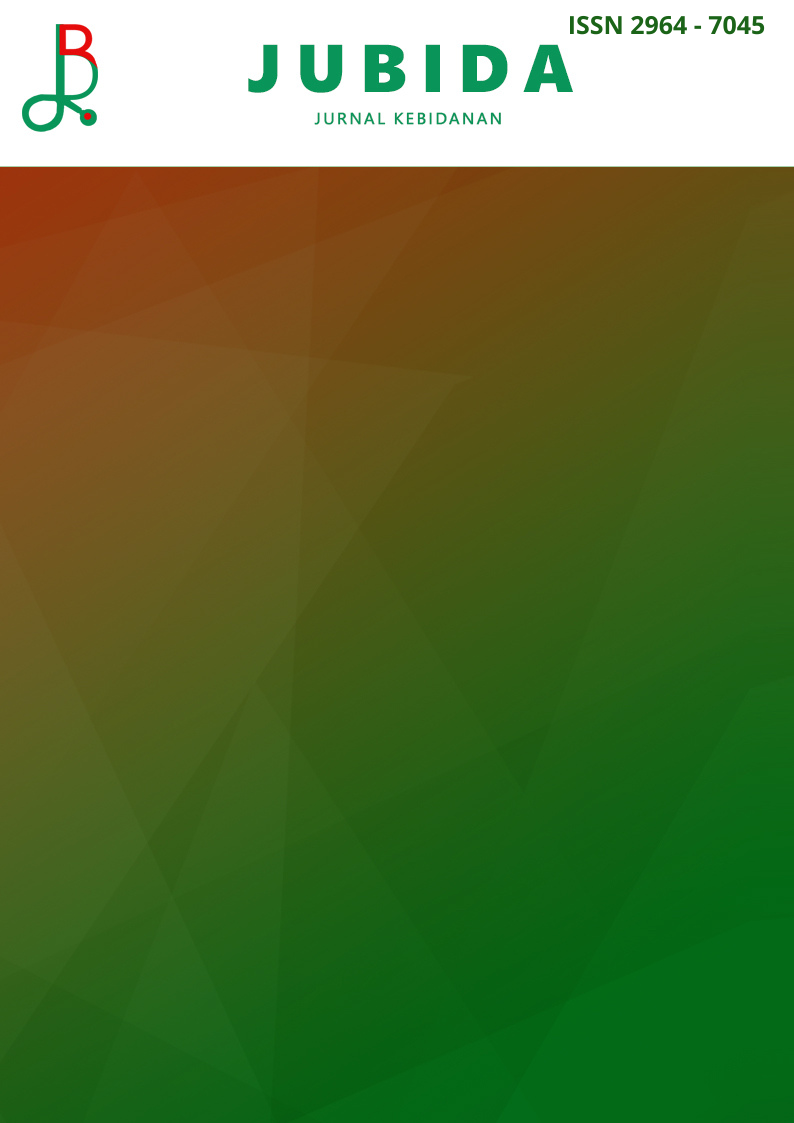LAPORAN KASUS: DIAGNOSIS DAN PENATALAKSANAAN MOLA HIDATIDOSA KOMPLET DENGAN MANIFESTASI BADAI TIROID
DOI:
https://doi.org/10.58794/jubida.v4i1.1539Keywords:
Penyakit Trofoblas Gestasional, Mola Hidatidosa Komplet, Kehamilan Molar dan komplikasi tirotoksikosisAbstract
Pendahuluan: Mola hidatidosa merupakan bentuk penyakit yang paling umum. Wanita pada tahap akhir reproduksi memiliki risiko lebih tinggi, terutama usia di atas 45 tahun. Komplikasi yang umum terjadi pada mola hidatidosa berupa perdarahan hebat sebelum deteksi dini dan teknik evakuasi uterus yang efektif. Mola invasif memiliki angka kematian sebesar 15% akibat perdarahan, embolisasi jaringan trofoblastik, dan sepsis. Komplikasi klasik mola hidatidosa selama kehamilan meliputi aborsi spontan, kematian intrauterin, hipertiroidisme, dan preeklamsia. Laporan kasus: Wanita 24 tahun, G2P1A0H1 dengan dugaan MHK memiliki riwayat perdarahan vagina, dengan USG menunjukkan gambaran honeycomb. Kuretase dilakukan pada pasien dan pemeriksaan histopatologi untuk mendukung diagnosis. Selain itu ditemukan kondisi badai tiroid tanpa adanya riwayat hipertiroidisme, sehingga diduga terjadi akibat mola hidatidosa komplet ini. Sehingga pada pasien diberikan penatalaksanaan badai tiroid. Kesimpulan: Pada pasien ini didapatkan diagnosis MHK dari anamnesis, penunjang seperti pemeriksaan USG, β-hCG, dan histopatologi. Penatalaksanaan dilakukan sesuai prinsip tatalaksana dengan kuretase untuk mengevakuasi mola dan mencegah perdarahan pasca operasi serta penatalaksanaan lain terkait komplikasi seperti anemia berat dan hipertiroidisme yang terjadi pada pasien ini. Diperlukan evaluasi lebih lanjut terkait kadar β-hCG yang dapat menentukan prognosis dan kekambuhan pada pasien, serta evaluasi dini terkait tiroid juga perlu dilakukan pada pasien dengan diagnosis mola hidatidosa.
References
J. T. Soper, ‘Gestational Trophoblastic Disease: Current Evaluation and Management’, Obstetrics and Gynecology, vol. 137, no. 2, pp. 355–370, Feb. 2021, doi: 10.1097/AOG.0000000000004240.
C. M. Joyce, B. Fitzgerald, T. V McCarthy, J. Coulter, and K. O’Donoghue, ‘Advances in the diagnosis and early management of gestational trophoblastic disease’, BMJ Medicine, vol. 1, no. 1, p. e000321, Dec. 2022, doi: 10.1136/bmjmed-2022-000321.
Cunningham, Lenovo, Bloom, et al. Chapter 20 Gestational Trophoblastic Disease in Williams Obstetrics 25th Edition. New York : Mc Graw Hill Education ; 2018. p.847-62.
A. Shaina Bruce and J. Sorosky, ‘Gestational Trophoblastic Disease’.
A. Lauren Cue, F. Farci, S. Ghassemzadeh, and M. Kang Affiliations, ‘Hydatidiform Mole Continuing Education Activity’.
E. Yamamoto, K. Nishino, K. Niimi, and K. Ino, ‘Epidemiologic study on gestational trophoblastic diseases in Japan’, J Gynecol Oncol, vol. 33, no. 6, Nov. 2022, doi: 10.3802/jgo.2022.33.e72.
P. : Jurnal, K. Masyarakat, I. Dewa, G. Dika Suarsawan, F. Dinata, and E. P. Manurung, ‘Pendekatan Diagnosa Mola Hidatidosa : Laporan Kasus’.
A. Almujahid, Syamel Muhammad, and Asterina, ‘Relationship Between Risk Factors and The Incidence of Gestational Trophoblastic Neoplasia at RSUP Dr. M. Djamil Padang Year 2019-2021’, Andalas Obstetrics And Gynecology Journal, vol. 8, no. 2, pp. 746–753, Jul. 2024, doi: 10.25077/aoj.8.2.746-753.2024.
A. Florea et al., ‘Hydatidiform Mole—Between Chromosomal Abnormality, Uniparental Disomy and Monogenic Variants: A Narrative Review’, Dec. 01, 2023, Multidisciplinary Digital Publishing Institute (MDPI). doi: 10.3390/life13122314.
J. V. B. Pereira and T. Lim, ‘Hyperthyroidism in gestational trophoblastic disease – a literature review’, Dec. 01, 2021, BioMed Central Ltd. doi: 10.1186/s13044-021-00092-3.
H. Y. S. Ngan et al., ‘Diagnosis and management of gestational trophoblastic disease: 2021 update’, International Journal of Gynecology and Obstetrics, vol. 155, no. S1, pp. 86–93, Oct. 2021, doi: 10.1002/ijgo.13877.
M. Shahzadi et al., ‘Review of current literature on gestational trophoblastic neoplasia’, Dec. 01, 2023, Springer Science and Business Media Deutschland GmbH. doi: 10.1186/s43046-023-00195-y.
P. Hui, ‘Gestational Trophoblastic Disease: Diagnostic and Molecular Genetic Pathology’. [Online]. Available: http://www.springer.com/series/7632
J. Gonzalez, M. Popp, S. Ocejo, A. Abreu, H. F. Bahmad, and R. Poppiti, ‘Gestational Trophoblastic Disease: Complete versus Partial Hydatidiform Moles’, Jul. 01, 2024, Multidisciplinary Digital Publishing Institute (MDPI). doi: 10.3390/diseases12070159.
J. Yang et al., ‘Genetic screening of Chinese patients with hydatidiform mole by whole-exome sequencing and comprehensive analysis’, J Assist Reprod Genet, vol. 39, no. 10, pp. 2403–2411, Oct. 2022, doi: 10.1007/s10815-022-02592-z.
P. Hui, ‘Germline NLRP7 mutations: genomic imprinting and hydatidiform mole’, doi: 10.1007/s00428-020-02802-y/Published.
S. Sharma, S. Sharma, L. Gandrabur, B. Amin, R. Rehmani, and A. Singh, ‘Molar Pregnancy Complicated by Impending Thyroid Storm’, Cureus, Nov. 2021, doi: 10.7759/cureus.19656.
D. Cerlova Milano and S. Muhammad, ‘Andalas Obstetrics And Gynecology Journal Uterine Rupture due to Gestational Trophoblastic Neoplasia on Nulliparous Woman : A Case Report’, [Online]. Available: http://jurnalobgin.fk.unand.ac.id/index.php/JOE
Downloads
Published
Issue
Section
License
Copyright (c) 2025 JUBIDA- Jurnal Kebidanan

This work is licensed under a Creative Commons Attribution-ShareAlike 4.0 International License.
JUBIDA - Journal of Midwifery provides open access to anyone, ensuring that the information and findings in the article are useful to everyone. This journal article's entire contents can be accessed and downloaded for free. In accordance with the Creative Commons Attribution-ShareAlike 4.0 International License.

JUBIDA - Journal of Midwifery is licensed under a Creative Commons Attribution-ShareAlike 4.0












